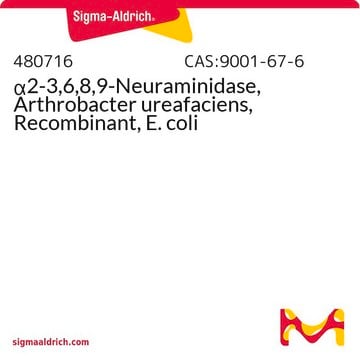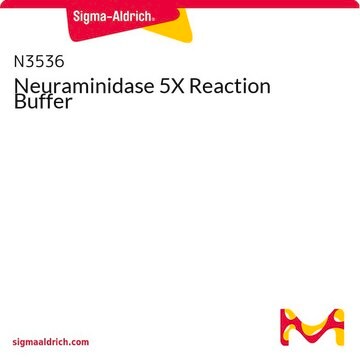10269611001
Roche
Neuraminidase (Sialidase)
from Arthrobacter ureafaciens
Synonyme(s) :
PCR, taq
About This Item
Produits recommandés
Source biologique
bacterial (Arthrobacter ureafaciens)
Niveau de qualité
Forme
solution
Activité spécifique
~25 units/mg protein
Conditionnement
pkg of 1 U (100 μl)
Fabricant/nom de marque
Roche
pH optimal
5.0-5.5
Température de stockage
2-8°C
Description générale
Spécificité
Application
- cell surface lectin array analysis.
- hemagglutination assays.
- cell adhesion assay.
- detection of the cell surface glycosylations in human anaplastic large cell lymphoma cells
- release of sialic acid from cells
- antibody-overlay lectin microarray
Propriétés physiques
Forme physique
Notes préparatoires
Autres remarques
Mention d'avertissement
Warning
Mentions de danger
Conseils de prudence
Classification des risques
Skin Sens. 1
Classe de danger pour l'eau (WGK)
nwg
Point d'éclair (°F)
does not flash
Point d'éclair (°C)
does not flash
Certificats d'analyse (COA)
Recherchez un Certificats d'analyse (COA) en saisissant le numéro de lot du produit. Les numéros de lot figurent sur l'étiquette du produit après les mots "Lot" ou "Batch".
Déjà en possession de ce produit ?
Retrouvez la documentation relative aux produits que vous avez récemment achetés dans la Bibliothèque de documents.
Les clients ont également consulté
Protocoles
Neuraminidase can be used to cleave sialic acids from proteins. In this protocol, the enzyme from Vibrio cholerae is used on fixed cells.
Notre équipe de scientifiques dispose d'une expérience dans tous les secteurs de la recherche, notamment en sciences de la vie, science des matériaux, synthèse chimique, chromatographie, analyse et dans de nombreux autres domaines..
Contacter notre Service technique








